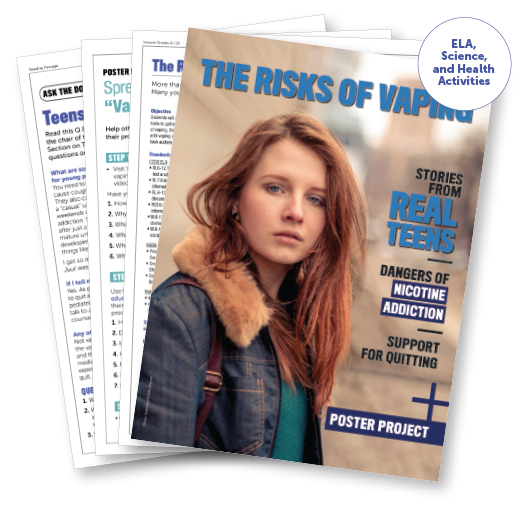VAPING PREVENTION & EDUCATION
LESSON PLAN: THE RISKS OF VAPING MAGAZINE

Objectives
Students will analyze informational texts to gather evidence about the risks of vaping and then create a persuasive, anti-vaping infographic/poster for a teen audience.
Standards: 6th-12th grade
CCSS ELA
- RI.6-12.1 Cite evidence to support text analysis
- RI.7.9 Analyze how two texts present information
- SL.6-12.1 Engage in collaborative discussions
- RST.6-10.7 Express quantitative information visually
- W.6-12.1 Write arguments to support claims
- W.6-12.2.D Use domain-specific vocabulary
NGSS
- Practice: Obtaining, Evaluating, and Communicating Information
- Crosscutting Concept: Cause and Effect: Mechanism and Prediction
- Core Idea: MS/HS-LS1.B Growth and Development of Organisms
National Health Education Standards
- #7: Avoid or reduce health risks
- #8: Advocate for personal, family, or community health
MATERIALS:
Length of Lesson:
60 Minutes
LESSON PLAN: The Risks of Vaping Magazine
Activities: Reading Activity, Nonfiction Text Analysis, Create a Poster or Infographic
Students will analyze informational texts to gather evidence about the risks of vaping and then create a persuasive, anti-vaping infographic/poster for a teen audience.
NONFICTION TEXT ANALYSIS
- Share The Risks of Vaping magazine with your students and discuss key facts about how vaping can affect their health. Use the questions included in step 3 of the Project: "Vaping's Not Our Thing" page to guide the discussion.
- Ask: Why do you think the teens from the videos of the magazine chose to share their experiences? How do their first-person accounts support the scientific information in the text?
- Help remove the stigma around seeking help for vaping by using person-first language. For example, instead of saying "addict", use the phrase "a person with nicotine addiction."
READING ACTIVITY
- Ask students, individually or as pairs, to read the article, Ask the Doctor: Teens and Vaping.
- Have students respond in writing to the questions at the bottom of the sheet. Then, discuss as a group to address any misconceptions.
- Discuss how this text compares with the article The Scary Truth About Vaping from the student magazine.
- Writing Extension: Have students write a persuasive essay synthesizing the information in the texts they read.
CREATE A POSTER OR INFOGRAPHIC
- Challenge your students to help keep their fellow teens safe by creating a persuasive poster to hang up around school. They’ll take what they have learned to create a poster or infographic that aims to convince their peers to avoid or quit vaping.
- Refer to the Project: "Vaping's Not Our Thing" and Project Rubric pages to help students self-assess and refine their posters as they work.
- Optional: Share and discuss examples of posters and infographics, such as those found on FDA's Tobacco Education Resource Library.
- Display posters in the halls and around your classroom or share them over small-group video calls.

